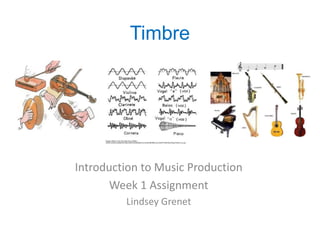
Week 1 assignment - Timbre
- 1. Timbre Introduction to Music Production Week 1 Assignment Lindsey Grenet
- 2. Introduction Hi, my name is Lindsey. I’m from Sydney, Australia. For our first assignment, I have chosen to examine the concept of timbre in more detail.
- 3. What is timbre? In music, timbre (pronounced TAM-ber) describes the quality or character of a sound or voice. Timbre helps your ears distinguish one type of sound production from another. For example, the sound of your cat from your dog. It is also referred to as tone colour or tone quality.
- 4. What is timbre? Timbre also helps us to differentiate instruments, even when they are playing the same pitch at the same volume. The flute, violin and glockenspiel can all play the same note at the same volume but sound very different due to their timbre.
- 5. How does this work? To understand timbre, we need to have a look at the property of sound it is related to:
- 6. Frequency: the amount of repeated sound waves produced in one second
- 7. Frequency Each repetition of a waveform is called a cycle Frequency measures cycles per second or Hertz (Hz) per second
- 8. Frequency Human hearing ranges roughly: 20 Hz – 20,000 Hz or 20Khz
- 9. Frequency In music, we hear changes in frequency as changes in the pitch. A high pitched note will have a greater number of sound wave repetitions per second than a lower pitched note.
- 10. Frequency More repetitions per second = higher frequency
- 11. How can we measure timbre? First, the instrument or voice needs to produce a sound. instruments or this vibration is energy at voices play or sing multiple frequencies a note and create a occurring simultaneously vibration
- 12. The fundamental The frequency with the slowest rate is called the fundamental. It is also heard the loudest.
- 13. Harmonics The other frequencies are either harmonics, overtones or enharmonics.
- 14. Harmonics The example from our lesson in ‘Visualising Sound’ helps us understand the relationship between the fundamental and the harmonics or, what we call notes in the harmonic series.
- 15. Harmonics db Hz Using a saw tooth wave, we can see that timbre is shown as peaks at a number of frequencies in the spectrum analyser
- 16. Harmonics This peak is the fundamental
- 17. Harmonics db Hz These peaks are called harmonics. Each harmonic is an integer multiple of the fundamental.
- 18. Harmonics If the fundamental here was 25Hz, the frequencies of the harmonics would be 50Hz, 75Hz, 100Hz etc (The harmonics become harder to hear the higher they go, which is why the peaks get shorter in this graph)
- 19. Harmonics Every sound we hear has a different combination of a fundamental frequency and notes in the harmonic series, which gives each sound a unique timbre.
- 20. How do we describe tone colour? When listening to a voice or instrument, we can use words to describe how they sound. For example, the voices of the Simpsons characters: Marge: raspy, scratchy Bart: bright, clear Homer: warm, round
- 21. Listening examples You can also use describing words for instruments of the orchestra. For example: Piccolo: bright, shrill Flute: light, airy Oboe: warm, nasal Listen to these woodwind instrument excerpts and have a go at describing the tone colour of each
- 22. Why is timbre important in music? Composers have many instruments to choose from in their compositions. Each instrument can be used to portray different emotions and moods. A carefully chosen instrument can really enhance a piece of music.
- 23. Conclusion Timbre in music is a broad concept that can be examined both scientifically, in analysis, and subjectively, in the way we hear it. We have only scratched the surface, so feel free to do your own research into this vast and interesting component of sound. Thank you for your time and efforts in marking this assignment!